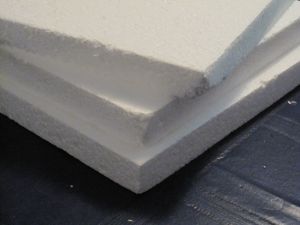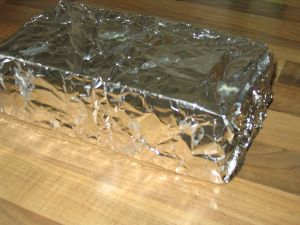Difference between revisions of "Insulation"
(image of a vacuum flask) |
(another image: foamed polystyrene) |
||
| Line 1: | Line 1: | ||
| − | [[Image: | + | [[Image:foamed_polystyrene.jpg|right|frame|Sheets of foamed polystyrene for insulation of houses.]] |
'''Insulation''' is needed to keep a [[colony]] warm and reduces the consumption of [[energy]] for heating. [[Aerogel]] or plastic [[foam]] may be utilized for insulation. [[Regolith]] may be heaped over buildings to keep in heat. [[Mineral wool|Mineral wools]], spun from local resources, may provide a lower tech alternative insulation. [[Fiberglass]], a type of mineral wool, is commonly used as insulation on Earth. [[Arsenic]] is a mineral that can be used as a heat tolerant insulation, but is toxic to life. | '''Insulation''' is needed to keep a [[colony]] warm and reduces the consumption of [[energy]] for heating. [[Aerogel]] or plastic [[foam]] may be utilized for insulation. [[Regolith]] may be heaped over buildings to keep in heat. [[Mineral wool|Mineral wools]], spun from local resources, may provide a lower tech alternative insulation. [[Fiberglass]], a type of mineral wool, is commonly used as insulation on Earth. [[Arsenic]] is a mineral that can be used as a heat tolerant insulation, but is toxic to life. | ||
| + | |||
| + | [[Image:vacuum_flask.jpg|left|frame|The glass body of a vacuum flask.]] | ||
The thin Martian [[atmosphere]] has a reduced capability for a convective flow of heat. More important is the heat radiation, which can be effectively reduced by choosing the material of the building's surface. A smooth bright metallic surface emits much less heat radiation than a rough black. A simple [[aluminium]] coated foil wrapped around the settlement modules provides excellent insulation. | The thin Martian [[atmosphere]] has a reduced capability for a convective flow of heat. More important is the heat radiation, which can be effectively reduced by choosing the material of the building's surface. A smooth bright metallic surface emits much less heat radiation than a rough black. A simple [[aluminium]] coated foil wrapped around the settlement modules provides excellent insulation. | ||
| − | [[Image: | + | [[Image:metal_foil_box.jpg|right|frame|A block of ice wrapped in aluminium foil to prevent melting.]] |
==Open issue== | ==Open issue== | ||
| Line 13: | Line 15: | ||
[[Category: Settlements]] | [[Category: Settlements]] | ||
[[Category: Technology]] | [[Category: Technology]] | ||
| − | |||
Revision as of 06:08, 3 July 2013
Insulation is needed to keep a colony warm and reduces the consumption of energy for heating. Aerogel or plastic foam may be utilized for insulation. Regolith may be heaped over buildings to keep in heat. Mineral wools, spun from local resources, may provide a lower tech alternative insulation. Fiberglass, a type of mineral wool, is commonly used as insulation on Earth. Arsenic is a mineral that can be used as a heat tolerant insulation, but is toxic to life.
The thin Martian atmosphere has a reduced capability for a convective flow of heat. More important is the heat radiation, which can be effectively reduced by choosing the material of the building's surface. A smooth bright metallic surface emits much less heat radiation than a rough black. A simple aluminium coated foil wrapped around the settlement modules provides excellent insulation.
Open issue
- What is the heat transition coefficient of regolith, aerogel and other materials?
- What can be produced in-situ with low energy consumption?









